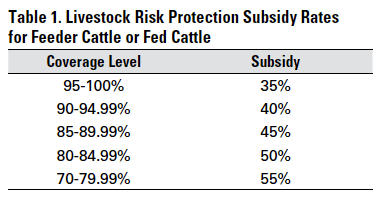Unlocking Development Possible: Bagley Risk Management Approaches
Unlocking Development Possible: Bagley Risk Management Approaches
Blog Article
Understanding Animals Risk Defense (LRP) Insurance: A Comprehensive Overview
Navigating the world of livestock risk security (LRP) insurance coverage can be an intricate endeavor for many in the farming sector. This sort of insurance coverage offers a safety web versus market variations and unanticipated situations that could affect livestock manufacturers. By understanding the ins and outs of LRP insurance, manufacturers can make informed choices that might secure their operations from financial risks. From just how LRP insurance works to the various coverage choices available, there is much to discover in this comprehensive overview that might potentially form the method livestock producers come close to threat management in their companies.

How LRP Insurance Policy Functions
Sometimes, understanding the mechanics of Animals Risk Defense (LRP) insurance coverage can be intricate, however damaging down exactly how it functions can offer quality for farmers and herdsmans. LRP insurance is a risk administration tool developed to shield animals manufacturers versus unexpected rate declines. The plan allows producers to set an insurance coverage degree based on their particular needs, picking the variety of head, weight array, and coverage price. When the plan remains in location, if market rates fall listed below the coverage price, producers can submit a claim for the difference. It is very important to keep in mind that LRP insurance coverage is not a revenue assurance; instead, it concentrates only on price threat security. The protection period generally ranges from 13 to 52 weeks, supplying flexibility for producers to select a duration that straightens with their manufacturing cycle. By utilizing LRP insurance policy, ranchers and farmers can mitigate the economic threats related to fluctuating market value, guaranteeing higher security in their operations.
Qualification and Insurance Coverage Options

When it comes to insurance coverage alternatives, LRP insurance coverage uses producers the adaptability to pick the insurance coverage degree, insurance coverage duration, and recommendations that finest fit their threat administration requirements. By recognizing the eligibility requirements and coverage choices readily available, animals manufacturers can make informed choices to manage threat successfully.
Pros and Cons of LRP Insurance Coverage
When reviewing Livestock Threat Protection (LRP) insurance policy, it is essential for livestock manufacturers to evaluate the downsides and advantages fundamental in this risk administration tool.

One of the primary advantages of LRP insurance policy is its capacity to provide defense versus a decrease in livestock rates. Furthermore, LRP insurance provides a degree of versatility, enabling manufacturers to tailor coverage degrees and policy periods to fit their certain demands.
One limitation of LRP insurance is that it does not secure versus all types of risks, such as condition episodes or all-natural disasters. It is vital for manufacturers to thoroughly examine their private risk direct exposure and monetary scenario to figure out if LRP insurance coverage is the right danger monitoring device for their operation.
Recognizing LRP Insurance Premiums

Tips for Maximizing LRP Advantages
Making the most of the benefits of Animals Danger Defense (LRP) insurance coverage requires tactical preparation and proactive risk management - Bagley Risk Management. To make the many of your LRP protection, consider the complying with ideas:
Routinely Examine Market Problems: Stay notified concerning market fads and rate changes in the livestock industry. By keeping an eye on these variables, you can make educated choices about when to buy LRP insurance coverage to shield versus possible losses.
Set Realistic you can look here Protection Degrees: When picking insurance coverage levels, consider your production prices, market price of livestock, and potential risks - Bagley Risk Management. Setting read this article realistic insurance coverage levels ensures that you are adequately secured without overpaying for unneeded insurance coverage
Diversify Your Coverage: As opposed to depending entirely on LRP insurance coverage, think about diversifying your danger administration strategies. Integrating LRP with various other threat management tools such as futures contracts or alternatives can provide comprehensive protection against market uncertainties.
Testimonial and Change Coverage Routinely: As market conditions change, periodically examine your LRP insurance coverage to guarantee it straightens with your present threat exposure. Adjusting insurance coverage levels and timing of purchases can help maximize your risk defense method. By adhering to these tips, you can make the most of the benefits of LRP insurance and protect your animals procedure versus unforeseen risks.
Conclusion
In final thought, animals danger defense (LRP) insurance coverage is a beneficial tool for farmers to manage the monetary risks connected with their animals procedures. By understanding exactly how LRP functions, qualification and coverage options, in addition to the advantages and disadvantages of this insurance, farmers can make educated decisions to safeguard their incomes. By very carefully considering LRP costs and carrying out methods to optimize advantages, farmers can alleviate prospective losses and make sure the sustainability of their operations.
Animals producers interested in acquiring Animals Risk Defense (LRP) insurance can discover an array of eligibility criteria and protection alternatives customized to click here for more info their particular animals procedures.When it comes to insurance coverage choices, LRP insurance policy uses producers the adaptability to choose the insurance coverage degree, insurance coverage period, and endorsements that best fit their danger monitoring requirements.To comprehend the intricacies of Animals Threat Protection (LRP) insurance fully, recognizing the variables influencing LRP insurance policy costs is critical. LRP insurance policy costs are identified by numerous aspects, consisting of the insurance coverage level picked, the anticipated rate of livestock at the end of the protection period, the type of animals being guaranteed, and the size of the coverage duration.Testimonial and Readjust Protection Regularly: As market conditions change, regularly evaluate your LRP insurance coverage to guarantee it straightens with your present threat direct exposure.
Report this page